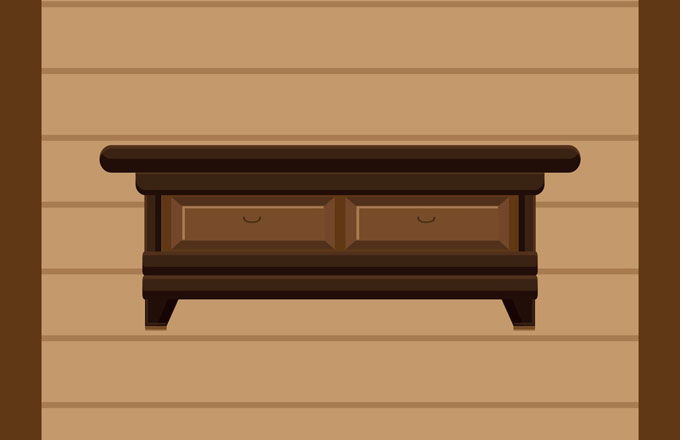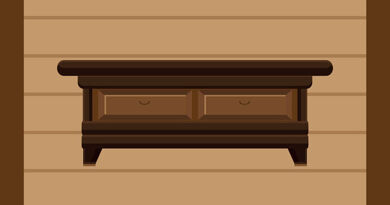Creole furniture suite
The history of Creole furniture is inevitably linked to that of men, their habitat first, their way of life in a specific region, and their evolution over the ages. From the first Amerindian inhabitants, we received from the pen of the chroniclers of time, the detailed description of summary constructions, whose names, today, only designate places: “Carbet”, “Ajoupa”, “Mouina”. These ingenious warriors adapted to their needs the natural materials found on the spot: wood, leaves, bark, cotton, earth, shells, etc …
Father Dutertre, in 1654, described their “huts” as follows: “They are made of forks of trees planted in the ground, joined with other pieces of wood that hold together. On top of that, they put rafters that go to the ground, and cover everything with latanier leaves and reeds. They make a big one, common to all they call Carbet … around, they make small ones for each household ”: the Mouinas. It is obvious that in such rudimentary living conditions, the furniture can only be “extremely simple, reduced to the essential, and also dependent on the surrounding natural resources”.
Father Labat, a little later (1742) visiting the Caribbean chef “La Rose” at Robert, gives us a similar overview: after describing the Carbet, he adds: “the first room served as kitchen (where s ‘busy the women) … the second bedroom was apparently used to sleep all these women with children who are not yet admitted to the Grand Carbet. There was no other furniture than hammocks and baskets: these also serve as a chest and wardrobe. We store everything: linen, charms, weapons, or fishing objects … The other, also called “cotton bed” is practical: you can take it everywhere with you “. It takes no place, and can be fixed by two wooden cleats, or two crampons “in addition to this convenience, which is considerable, one sleeps there cooler, one needs neither pillow, nor cover. It doesn’t embarrass the room, because you can fold it when you no longer need it. ”
Sitting on the floor, there is no need for a table. They eat in the “Matoutous” kinds of square baskets, without a lid, “whose corners are carried on four small painted and worked sticks which go beyond the edges properly terminated by a ball, or cut with sides. The bottom and the side are worked so tightly, that one can fill them with water, without fear that it will run out, although it is only made of reeds and leaves of latanier. Those who eat put two in front of them: one for the cassava, the other for fish, meat or crabs, with a chili peppers. ”
The arrival of the settlers did not change much with this inventory. More concerned about their subsistence and their life, in addition to the Fort (built in concrete to prevent any attack) they build wooden huts, covered with leaves, where there is little more than a rough table, a few rudimentary seats, benches or wooden logs, storage chest. They sleep in hammocks. Father Bouton writes: “The French are no more curious about the goodness and the softness of the beds of France than the beauty of the houses. They sleep in hanging beds called hammocks, which are still used as seats during the day. The most careful have a wooden chest in which they tighten their clothes ”.
The first permanent house built in Saint-Pierre was that of Belain d’Esnambuc. Clinging to Morne Abel (just above the theater), accessible by a bridleway, we know nothing of its furnishings, but we can still admire a bathtub dug in a single block of marble, and the remains from his oratory. Then, “General Du parquet, governor and first owner of the island, had built himself a very beautiful house, 3/4 leagues from the fort, on a height which he had cleared with much expense. The building was initially made of wood, but having discovered a quarry a short distance away, he had it rebuilt in cut stone. “
The monks also built solid buildings, which were furnished with simple but functional furniture: “the parish church of Saint-Pierre (that of the Fort) is of masonry – portal in cut stones, of Doric order, with second-rate penthouse … that of Saint-Dominique serves as a parish at Mooring. The altars, evangelical pulpit and benches’ are in good taste. We are indebted to its construction to the officers of the king’s vessels. ” .
The first wood craftsmen were, without a doubt, the shipwrights. It is true that the inhabitants, then, were more occupied with their subsistence, and the harvesting of marketable products, than with domestic comfort. They were content with the bare necessities. The furniture was basic. Father Dutertre notes: “the vanity that reigns in clothes, has not yet reached the piece of furniture, because some chests, a table, a bed furnish the furniture; married people have a bed like in France, but the others have only cotton beds, in which they lie down like the savages ”.
Metropolitan artisans, despite the advantages that the King had granted them (namely that after 10 years spent overseas, to practice their art, they would be allowed to run a boutique in Paris, a dream almost inaccessible, but very popular, because we styles were launched there, and people made a name for themselves there). Duparquet complained, in a letter to the Company, “to lack masons, bricklayers, stonemasons, carpenters, carpenters, nailers, roofers” etc … claiming that he was sent subject to their exercise that their job, being forbidden to exploit any tropical culture …
In 1666, the workers were still few. Their demands, their laziness and their arrogance led the Sovereign Council to issue an ordinance which regulated their working conditions, fixed their earnings and their timetables. ” They had to start 1/4 hour before sunrise, and finish 1/4 hour after sunset. Several provisions followed, concerning the insolence of which all the inhabitants complained, the mutiny, and their responsibility in the event of defect. “The need for their services softened the rigors of the law, and made the employers more accommodating, so much so that, very quickly, they resumed their demands. In 1678, Blénac informs the minister that they are paid six times more than they should be … ”
The colonists who employed them added gifted and skilled slaves to manual work, who quickly acquired the notions necessary for working with wood. It was thus formed, on the dwellings, workers able to copy the pieces of furniture, first imported (tendency quickly restrained by an ordinance aiming at preserving the local craft industry), then manufactured by the metropolitan craftsmen who reproduced, with the wood of the country, what they had done in France.
These black workers went from house to house, “loaned” by the owners, and received wages which they had the right to keep for their use. They thus acquired a nest egg which allowed them, thereafter, to buy their freedom. As early as 1700, Father Labat wrote “Although a carpenter is not so necessary, he does not stop being of great use, and when he can turn and is a good worker, he does a thousand services in a House. When there is no work to give him, he never misses it among the other inhabitants, most of whom prefer to use a negro, than a white, when they are also skilled. The least such a worker can earn is a crown a day, in addition to his food, and when he has with him an apprentice or a journeyman, this sometimes goes up to a hundred and fifty.
This preference of Creoles to employ people of color rather than white workers explains the importance of this free group in 1710. As of 1692, the Sovereign Council, the clerks, and the inhabitants, had been invited to settle in the new city, Fort Royal, then under construction, which was to become the chief town of Martinique. The artisans had flocked there metropolitan, free blacks, half-bloods, who vegetated in the boroughs, awaiting a random or seasonal job. They had opened a shop there, and settled there.
The development of the culture of the cane, and the prosperity which followed from there, allowed a development of the habitat. The inhabitants, although more concerned with their clothing, their teams, and their hospitality, began to be seduced by the furniture. In the hall of the house: a marble table about 5 feet long by 2 wide mounted on its frame with turned legs, another oval wooden table from the country of 4 p. L. on its chassis in poor condition and a country chair woven with straw.
In the galley, there is an old buffet with two doors, not locked, an old 6P bed wood. of L. of 4, with turned feet, a small cupboard of local wood locking, in bad condition, a bad table of 8P L. on 4 of L. of sape wood on chassis. Item, a tailgate in poor condition, of 6P of L., a trunk of 6P of L. x 41/2, a ladder of 19 P of L. and another small flying ladder of 6P of L. A jar of Provence in bad condition, a fire dog in good condition (follow tools). In the kitchen: a kneader, an iron spit, a board serving as a buffet, a pestle handle … The black workers, trained to execute what the metropolitan craftsman reproduced from the style and forms in use, or in fashion, in France, once installed in their own workshop, were no longer content to copy the models. They incorporated something of their own, or gave free rein to their creativity.
Having become free, and sometimes “workshop masters”, directing their own slaves themselves, when the number of orders required a larger workforce, they were free to interpret the forms as they wished, and according to their inspiration. “Their ingenuity and intelligence were able to adapt fashions to the requirements of the climate and tropical woods, creating furniture that combined a certain kinship of style, with that of furniture from another region at the same time, but which acquired therefore, originality and own personality. ”(1) The first consequence of this state of affairs was that in the houses of the masters as in the huts, the furniture was the same.
In “Voyages et aventures du Chevalier de … (1769) (2) we read:” as soon as we had dinner … I went to throw myself on a daybed which was behind the door of a cabinet which, on one side opened into a gallery which led to the apartments … ” Closer to home, Father Delawarde (3), describing the little farmer’s hut in the countryside, writes: “inside (in the room) there is a table, and for rest or chat, a bench sometimes provided with a file ”. We recognize the Creole “coucheton”, a narrow couch, having only one top of planks, on four legs often turned, stripped form of the Récamier couch or the English meridian.
The chest, quoted by the chroniclers, is found in the small cultivator: “chests and boxes, sometimes old, contain herds from which emit the scent of vetiver or mahogany shavings. They are made of beautiful wood: mahogany, mahogany, breadfruit or even “country cypress”.
The column bed “In the next room, semi-dark, a night light trembles in front of a crucifix … Very often, a large bed with columns, turned in the hard courbaril, inherited from the ancients, or bought inexpensively, clutters the cramped room. It is a beautiful piece of furniture that is no longer made. Its venous columns with simplified moldings, with bastard curves, rise to support the mosquito net that is missing here. Its high feet allow you to watch, in the evening, if a snake is not coiled underneath … “(4)
They were manufactured very early in the Antilles, from Louis XV, but the real Louis XV style beds, with crowbars and shells, are practically unobtainable in Martinique. Column beds have a wide variety of aspects: the large ball columns of the “corsair” bed in courbaril, also called “zizim-tollé” by the ancients, the thin slender columns, inspired by English Victorian style furniture. For those turned “into balusters” reminiscent of the Louis XIV style, their more or less elaborate forms seem more due to the artistic inspiration of the craftsman, than to the influence of fashion. The “canopy” which crowned the whole, supporting the heavy curtains, gave way to the mosquito net. We sometimes meet a “canopy”. The beds that have been found in Guadeloupe are much more worked than those that come from the Martinican heritage. Twists in flames, of English inspiration, or derived from the Louis XIV distaff bed are more frequent. The mix of styles nevertheless remains undeniable here, as in other elements of the furniture. The principles of decoration remain quite limited: balls, macaroons, horizontal or longitudinal streaks; yet the sculptor’s verve, and his dexterity, sometimes engraved a stylized fruit (pineapple) in the wood.
The console: its dimensions are in feet and inches, measurements used before Louis XVI, allowing to affirm that this very beautiful piece of furniture dates from the 18th century. It was most probably the table of the public writer. Its height is calculated to be used upright. There too, the imagination has turned the most varied and original columns, and the influence of “style furniture” has made several variants.
The trunk rises, we add feet. It no longer opens on top, but on the front: we put drawers … It becomes “convenient”. Most are inspired by the Directoire or Restauration style. There is also the “cupboard bottom” in the bedrooms. The same piece of furniture at the pantry is called “buffet”. We put the dishes there. Very quickly, the craftsmen added to it a body with shelves, with a pediment carved in high relief, where the ingenuity of the artist is inspired by decorative patterns of different styles. Larger and closed, it is the wardrobe. It is undeniable that it is the Louis XV style that is in vogue. We find it in the curve of the feet, in the moldings decorating the doors, often worked in two shades of wood. Inspired by the Empire or the Directory, the simple, clean lines are enhanced by cornices with more or less significant projections, and legs turned with Louis XVI grooves in the uprights …
The “pulpits” of the Middle Ages, which became armchairs, with all the variations brought to them by the various styles, settled, under the influence of the English “rocking chair”, on long rounded supports, to swing nonchalantly. Their originality lies in the curve of the rear legs, curved or straight, the decoration of the front legs and the spacers. Sometimes a sculpted subject adorns the top of the backrest. Placed on the ground, on their four feet, others see the length of their arms double and articulate. Deployed, you can put your legs there, like in a lounge chair; folded, only the forearms and hands find support. It’s the planter’s chair …
The period furniture found in the Antilles has, in fact, become rare. The tormented history, the cyclones, the fires, the negligence and the “fashion” made disappear many. The ease of communication, and the revival taste for this type of furniture, inherent in our culture, had encouraged a great mix between the various Antillean furniture, from neighboring islands. This trend now stopped, it is again up to the artisans to revive, with all the perfection of their art, a tradition inseparable from our cultural identity.
1: Emile Hayot – free people of color at Fort Royal – 1679-1823 – p. 3 2: “Voyages and adventures of the Knight of XXX” – 1st part – London – Paris 1769 p. 25 3: Delawarde: peasant life in Martinique – Essay on human geography – Fort-de-France 1937 p. 156 4: F. Darmezin de Garlande & J. Poupon – Furniture art in Martinique – p. 12-13
by Marie Chomereau-Lamotte




